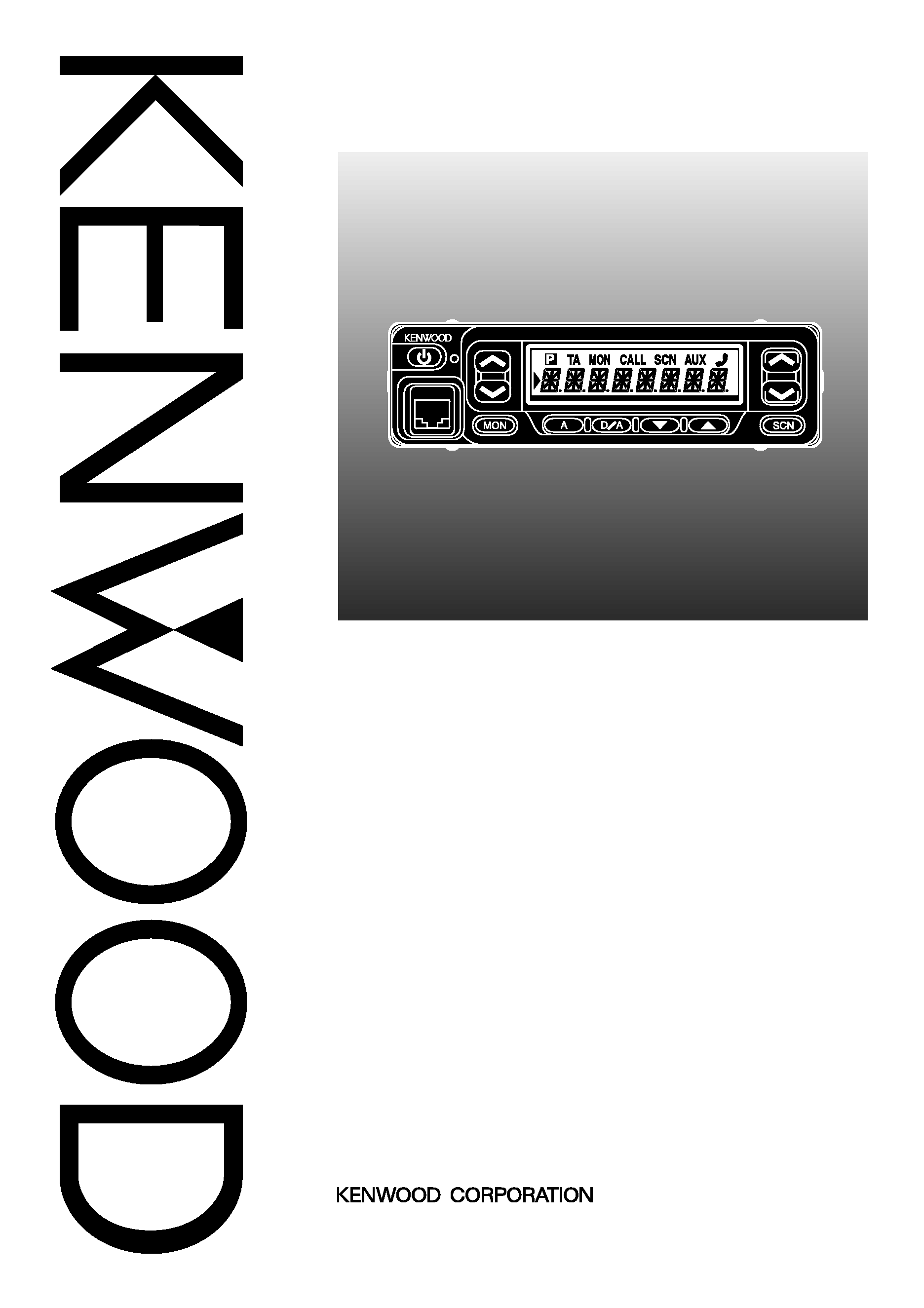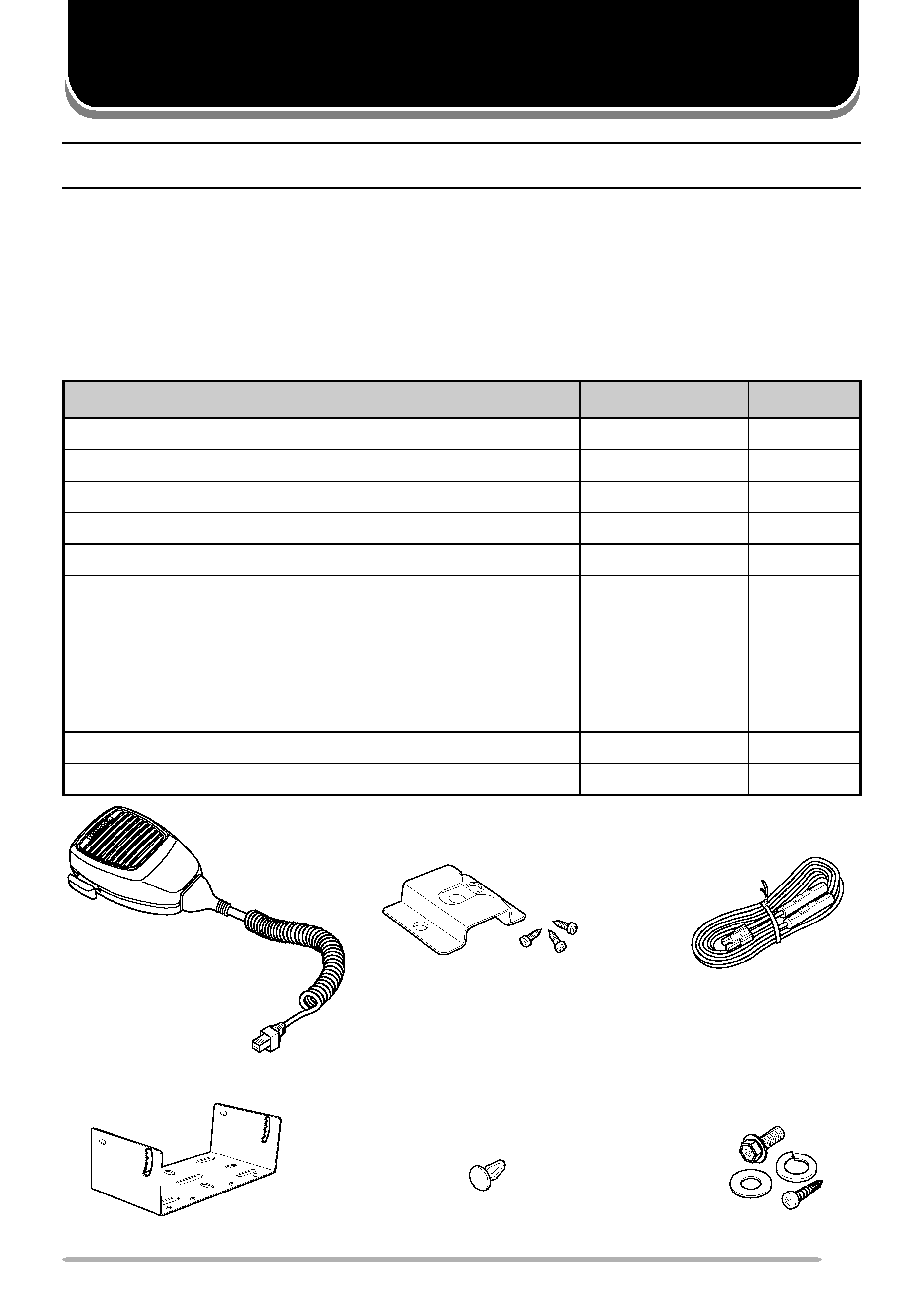
INSTRUCTION MANUAL
UHF FM TRANSCEIVER
TK-863G
© B62-1577-10 (K)
09 08 07 06 05 04 03 02 01

THANK YOU!
We are grateful you chose KENWOOD for your personal mobile applications. We
believe this easy-to-use transceiver will provide dependable communications to keep
personnel operating at peak efficiency.
KENWOOD transceivers incorporate the latest in advanced technology. As a result,
we feel strongly that you will be pleased with the quality and features of this product.
One or more of the following statements may be applicable:
FCC WARNING
This equipment generates or uses radio frequency energy. Changes or modifications to this
equipment may cause harmful interference unless the modifications are expressly approved in the
instruction manual. The user could lose the authority to operate this equipment if an unauthorized
change or modification is made.
INFORMATION TO THE DIGITAL DEVICE USER REQUIRED BY THE FCC
This equipment has been tested and found to comply with the limits for a Class B digital device,
pursuant to Part 15 of the FCC Rules. These limits are designed to provide reasonable protection
against harmful interference in a residential installation.
This equipment generates, uses and can generate radio frequency energy and, if not installed and
used in accordance with the instructions, may cause harmful interference to radio communications.
However, there is no guarantee that the interference will not occur in a particular installation. If this
equipment does cause harmful interference to radio or television reception, which can be
determined by turning the equipment off and on, the user is encouraged to try to correct the
interference by one or more of the following measures:
·
Reorient or relocate the receiving antenna.
·
Increase the separation between the equipment and receiver.
·
Connect the equipment to an outlet on a circuit different from that to which the receiver is
connected.
·
Consult the dealer for technical assistance.

i
GOVERNMENT LAW PROHIBITS THE OPERATION OF UNLICENSED RADIO
TRANSMITTERS WITHIN THE TERRITORIES UNDER GOVERNMENT CONTROL.
ILLEGAL OPERATION IS PUNISHABLE BY FINE OR IMPRISONMENT OR BOTH.
REFER SERVICE TO QUALIFIED TECHNICIANS ONLY.
SAFETY: It is important that the operator is aware of, and understands, hazards
common to the operation of any transceiver.
WARNING!
EXPLOSIVE ATMOSPHERES (GASES, DUST, FUMES, etc.)
Turn OFF your transceiver while taking on fuel or while parked in gasoline service stations.
Do not carry spare fuel containers in the trunk of your vehicle if your transceiver is mounted
in the trunk area.
INJURY FROM RADIO FREQUENCY TRANSMISSIONS
Do not operate your transceiver when somebody is either touching the antenna or standing
within two to three feet of it, to avoid the possibility of radio frequency burns or related
physical injury.
DYNAMITE BLASTING CAPS
Operating the transceiver within 500 feet of dynamite blasting caps may cause them to
explode. Turn OFF your transceiver when in an area where blasting is in progress, or where
"TURN OFF TWO-WAY RADIO" signs have been posted. If you are transporting blasting
caps in your vehicle, make sure they are carried in a closed metal box with a padded interior.
Do not transmit while the caps are being placed into or removed from the container.
NOTICES TO THE USER
PRECAUTIONS
Please observe the following precautions to prevent fire, personal injury, and
transceiver damage.
· Do not attempt to configure the transceiver while driving; it is too dangerous.
· Do not modify the transceiver for any reason.
· Do not expose the transceiver to long periods of direct sunlight, nor place it
close to heating appliances.
· Do not place the transceiver in excessively dusty, humid, or wet areas, nor on
unstable surfaces.
· If an abnormal odor or smoke is detected coming from the transceiver, switch
OFF the power immediately. Contact your KENWOOD dealer.

ii
CONTENTS
UNPACKING AND CHECKING EQUIPMENT ................................... 1
SUPPLIED ACCESSORIES ..................................................................... 1
PREPARATION .................................................................................. 2
TOOLS REQUIRED .............................................................................. 2
POWER CABLE CONNECTION ............................................................... 2
INSTALLING THE TRANSCEIVER .............................................................. 3
ORIENTATION .................................................................................... 4
FRONT PANEL AND MICROPHONE ......................................................... 4
DISPLAY ............................................................................................ 5
REAR PANEL ..................................................................................... 5
PROGRAMMABLE AUXILIARY FUNCTIONS .................................. 6
BASIC OPERATIONS ........................................................................ 7
OPERATION OVERVIEW ........................................................................ 7
SWITCHING POWER ON/ OFF ............................................................. 7
ADJUSTING THE VOLUME ..................................................................... 7
SELECTING A SYSTEM/ GROUP ............................................................. 7
TIME-OUT TIMER (TOT) ...................................................................... 7
HORN ALERT ..................................................................................... 7
TRUNKED OPERATION .................................................................... 8
PLACING A DISPATCH CALL ................................................................. 8
RECEIVING A DISPATCH CALL .............................................................. 8
PLACING A TELEPHONE CALL ............................................................... 9
RECEIVING A TELEPHONE CALL ............................................................ 9
CONVENTIONAL OPERATION ....................................................... 10
TRANSMITTING ................................................................................. 10
RECEIVING ...................................................................................... 10
SCAN ................................................................................................ 11
SYSTEM SCAN ................................................................................. 11
Scanning Trunked Systems ................................................. 11
Scanning Conventional Systems ........................................ 11
Scan Lockout ........................................................................ 11
Scan Revert ........................................................................... 12
GROUP SCAN .................................................................................. 12
DTMF (DUAL TONE MULTI FREQUENCY) CALLS ........................ 13

1
UNPACKING AND CHECKING EQUIPMENT
Note: The following unpacking instructions are for use by your KENWOOD dealer, an authorized
KENWOOD service facility, or the factory.
Carefully unpack the transceiver. We recommend that you identify the items
listed in the following table before discarding the packing material. If any items
are missing or have been damaged during shipment, file a claim with the carrier
immediately.
SUPPLIED ACCESSORIES
Microphone and
microphone cable
DC power cable
Microphone hanger
with self-tapping screws
Mounting bracket
Screw set
Speaker jack cap
m
e
t
I
r
e
b
m
u
N
t
r
a
P
y
t
i
t
n
a
u
Q
e
l
b
a
c
e
n
o
h
p
o
r
c
i
m
d
n
a
e
n
o
h
p
o
r
c
i
MX
X
-
1
2
6
0
-
1
9
T1
s
w
e
r
c
s
g
n
i
p
p
a
t
-
f
l
e
s
h
t
i
w
r
e
g
n
a
h
e
n
o
h
p
o
r
c
i
MX
X
-
4
8
5
1
-
9
1
Jt
e
s
1
e
l
b
a
c
r
e
w
o
p
C
DX
X
-
9
3
3
3
-
0
3
E1
t
e
k
c
a
r
b
g
n
i
t
n
u
o
MX
X
-
7
2
6
0
-
9
2
J1
p
a
c
k
c
a
j
r
e
k
a
e
p
SX
X
-
5
3
2
0
-
9
0
B1
:
t
e
s
w
e
r
c
S
X
X
-
5
9
3
0
-
9
9
N1
)
s
e
c
e
i
p
4
(
w
e
r
c
s
g
n
i
p
p
a
t
-
f
l
e
S
·
)
s
e
c
e
i
p
4
(
r
e
h
s
a
w
h
t
i
w
w
e
r
c
s
d
e
d
a
e
h
-
x
e
H
·
)
s
e
c
e
i
p
4
(
r
e
h
s
a
w
g
n
i
r
p
S
·
)
s
e
c
e
i
p
4
(
r
e
h
s
a
w
t
a
l
F
·
)
y
l
n
o
a
d
a
n
a
C
/
.
A
.
S
.
U
(
d
r
a
c
y
t
n
a
r
r
a
W
1
l
a
u
n
a
m
n
o
i
t
c
u
r
t
s
n
IX
X
-
7
7
5
1
-
2
6
B1
